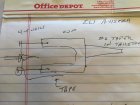I've been making spatulas lately, with handles tapering down to as little as 3/8" and overall lengths up to about 14". If I mount the pieces between centers, which gives me more flexibility for shaping and centering, I tend to get a lot of vibration when I'm working the slenderest part of the spindle, usually right at the midpoint.
I've gotten around this by holding the headstock end (which becomes the blade of the spatula) in my pin-jaw chuck, but the jaw alignment requires the pieces to be milled symmetrically before I put them on the lathe or I can't center the handle end on the tailstock live center. Since I use a lot of very random wood, I'd love it if I didn't have to put extra time into careful milling before turning.
I've tried various hand-holds to support the back or underside of the spindles while cutting (I use either a skew or detail gouge). If you know of any spindle technique videos that address this problem, could you provide a link or pointer? I'm not looking for steady-rest recommendations, just information on how to properly support a spindle while hand cutting.
Thanks!
Kalia
I've gotten around this by holding the headstock end (which becomes the blade of the spatula) in my pin-jaw chuck, but the jaw alignment requires the pieces to be milled symmetrically before I put them on the lathe or I can't center the handle end on the tailstock live center. Since I use a lot of very random wood, I'd love it if I didn't have to put extra time into careful milling before turning.
I've tried various hand-holds to support the back or underside of the spindles while cutting (I use either a skew or detail gouge). If you know of any spindle technique videos that address this problem, could you provide a link or pointer? I'm not looking for steady-rest recommendations, just information on how to properly support a spindle while hand cutting.
Thanks!
Kalia

